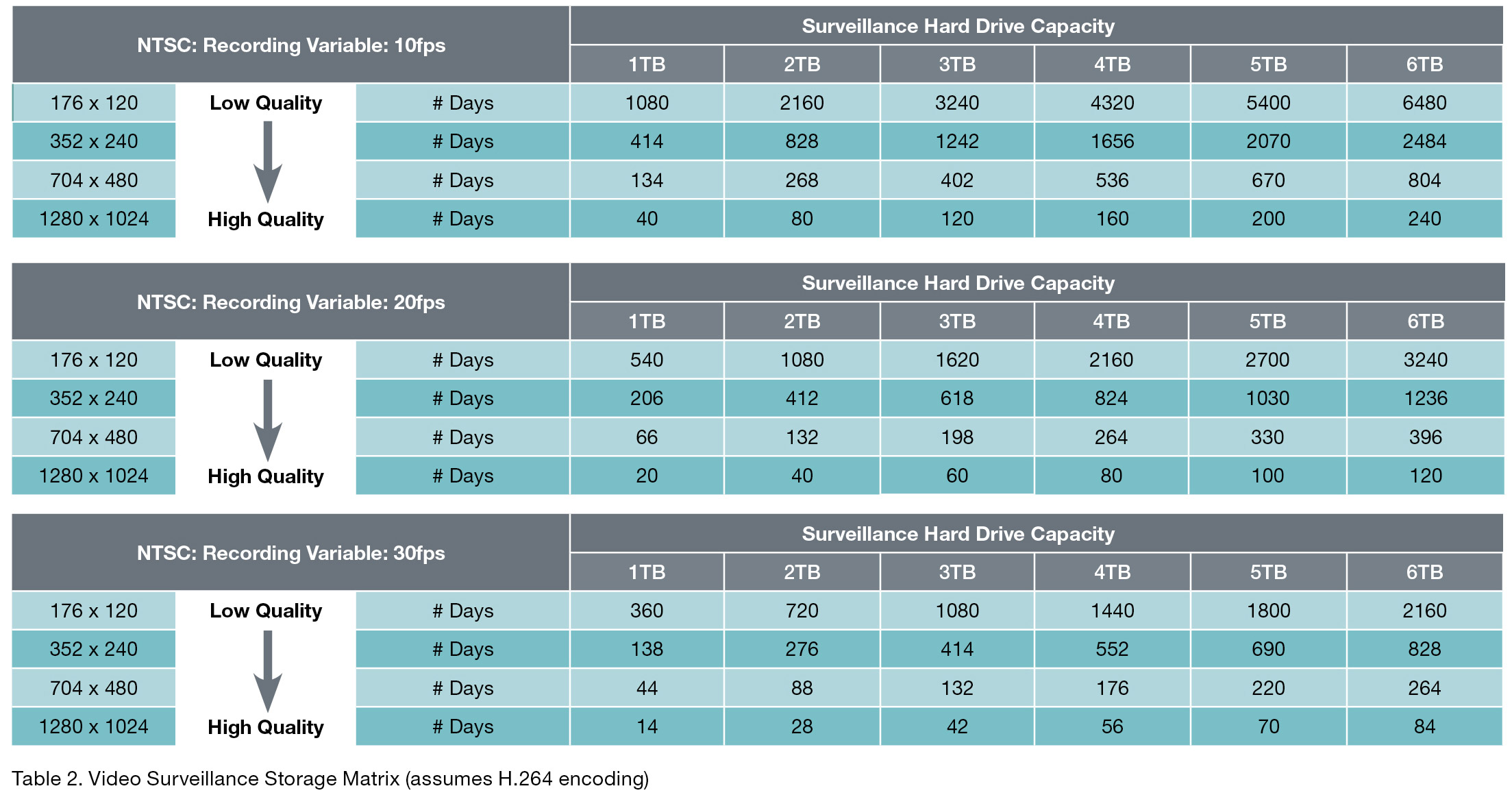While digital video surveillance systems offer an exceeding amount of rich features compared to their analog ancestors, they still require thoughtful design and deployment to ensure maximum cost-effectiveness. Among the various criteria that impact surveillance network video recorder (NVR) system value, storage capacity can be particularly significant and easily misunderstood.
- Higher image resolution
- More active cameras
- Longer archival periods
- Intelligent video recognition
Abundant storage capacity is a fundamental enabler of such capabilities, and it is here that some video surveillance deployments can go amiss. In an effort to minimize costs, some NVR systems may utilize multiple low-cost, low-capacity hard disk drives (HDD) to meet their storage requirements. On its surface, this approach appears to be a viable option to reduce storage expenditures.
In conventional computing environments, HDD capacity is typically viewed only in quantitative terms; how much data can the storage system hold? But in the context of NVR solutions, drive capacity plays a key role in determining both the quantity and quality of data that the system can store.
Because 24×7 video streams are the very lifeblood of NVR systems, to deliver superior performance and efficiency in a given security environment, these systems must have sufficient storage capacity to address three fundamental video parameters:
Quantity—the number and time duration of the video streams
Quality—the image quality of the video streams, expressed in terms of frame resolution (for example, 1280×1024 pixels) and frames per second (fps)
Archiving—the length of time the video streams will be stored
Video Balancing Act
Once the specific balance of video data quantity, quality, and archiving required for a given security application is determined, it’s easy to estimate the amount of storage capacity an NVR system must include. Simply go to one of the video surveillance storage matrix tables to select the table row that lists the frame resolution and fps needed for each 24×7 video stream, then read across to find the nearest desired archival period (shown in days) and the corresponding drive capacity required for each individual stream.
Note: Table 1 reflects MPEG-4 compression, while Table 2 reflects the H.264 encoding; results will vary depending on video compression formats and specific video recording applications used.


The tables show the enormous variation in HDD recording capacity based on a 24×7 video stream’s resolution and frames per second. Also refer to our Surveillance Storage Calculator that takes into account additional variables like video quality, compression type, and number of operational hours per day.
With so many security applications entailing dozens of cameras and 24×7 video streams, it soon becomes apparent that a typical NVR system’s storage requirements can easily reach beyond 10TB. In the following three examples, the varying video profiles of different security environments (and the storage capacities they require) are compared.
Example A: Extended Archiving
There are many businesses (point-of-sale and retail, restaurants, banks, and so forth) where high-resolution, full-motion 24×7 video streams are simply overkill. Typically employing a modest number of fixed cameras to record customer activity, NVR solutions in these environments are able to employ lower image resolution and fewer frames per second while still delivering sufficient video detail for subsequent review as needed.
When the quality of an NVR system’s 24×7 video streams can be relatively low, the benefits of greater HDD capacity come from enabling longer archival storage. In these cases we recommend SkyHawk™ surveillance hard drives, up to 8TB, for basic NVR video surveillance needs. Archive periods can be economically extended from a select number of days to months, or even years; indeed, continuous video signal at 10fps/352×240 resolution can be streamed onto a 6TB drive for 1596 days with MPEG-4 compression and an astounding 2484 days with H.264 encoding (refer to Table 1 and Table 2).
Example B: Enhanced Quality
Environments with more stringent security requirements (for example, schools, public buildings, and airports) rely on 24×7 video streams with higher resolution, and more frames per second to better identify suspicious persons and activity. Coupled with broader camera deployment, the enhanced video quality of such streams gives security personnel a more detailed, comprehensive view of the areas under surveillance. In these cases we recommend SkyHawk AI surveillance hard drives, up to 16TB, for simultaneously capturing both AI and video stream seamlessly and enhanced workload support.
Not surprisingly, the higher resolution, AI meta tagging, and frame rates of such 24×7 video streams can significantly increase the capacity requirements of an NVR system.
As shown in Table 1, just one continuous video stream at 20fps/704×480 image resolution can fill a 1TB drive in only 42 days with MPEG-4 compression. Table 2 shows how H.264 encoding extends video storage in this scenario to 66 days. Multiply that by the dozens of 24×7 video streams that such NVR systems typically employ, and the need for massive storage capacity quickly becomes clear.
Example C: Intelligent Video
Designed for maximum-security surveillance environments, intelligent video takes full advantage of the exceptional detail found in high-resolution, full-motion (30fps) 24×7 video streams to recognize visual patterns. The best-known use of this technology is facial recognition and predictive analytics; intelligent software analyzes objects, behaviors, and, in some cases, even faces in stored surveillance footage, comparing the video to known risks that the system is trained to identify. When a match is found, the application automatically notifies security personnel for follow-up investigation. In these cases we recommend SkyHawk AI drives, up to 16TB, for simultaneously capturing both AI and video stream seamlessly and enhanced workload support.
These high-resolution, full-motion 24×7 video streams deliver superlative visual quality, but do so at a price; they consume vast quantities of storage capacity. The tables show the voracious nature of such streams. Using MPEG-4 compression, a single continuous stream at 30fps/1280×1024 resolution fully exhausts the capacity of a 6TB drive in just 48 days, while H.264 encoding delivers approximately 84 days of the same quality video. If AI data is collected simultaneously alongside the video, this will also incrementally increase storage usage and should be accounted for.
Conclusion
Boasting an unprecedented blend of visual detail and storage capacity, network video recorder systems are spearheading a new era of surveillance effectiveness and flexibility. Purpose-built surveillance drives are key enablers of this revolution, storing enormous quantities of video data at remarkably low cost per GB. The result is surveillance systems that can seamlessly accommodate the unique image quality and extended archival needs of modern security environments.










